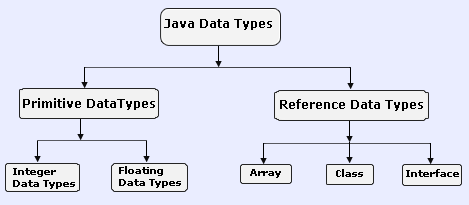Data type defines a set of permitted values on which the legal operations can be performed.

Java Data Types
Data type defines a set of permitted values on which the legal
operations can be performed.
In java, all the variables needs to be declared first i.e. before using a
particular variable, it must be declared in the program for the memory
allocation process. Like
int pedal = 1;
This statement exists a field named "pedal"
that holds the numerical value as 1. The value assigned to a variable
determines its data type, on which the legal operations of java are
performed. This behavior specifies that, Java is a
strongly-typed programming language.
The data types in the Java programming language are divided into two
categories and can be explained using the following hierarchy structure :

- Primitive Data Types
- Reference Data Types
Primitive Data Types
The primitive data types are predefined data types, which
always hold the value of the same data type, and the values of a
primitive data type don't share the state with other primitive
values. These data types are named by a reserved keyword in
Java programming language.
There are eight primitive data types supported by Java programming language :
byte
The byte data type is an 8-bit signed two's complement integer. It
ranges from -128 to127 (inclusive). This type of data type is useful to
save memory in large arrays.. We can also use byte
instead of int to increase the limit of the code. The syntax
of declaring a byte type variable is shown as:
| byte b = 5; |
short
The short data type is a 16-bit signed two's complement integer. It
ranges from -32,768 to 32,767. short is used to save memory in
large arrays. The syntax of declaring a short type variable is shown as:
| short s = 2; |
int
The int data type is used to store the integer values not the fraction
values. It is a 32-bit signed two's complement integer data type. It
ranges from -2,147,483,648 to 2,147,483,647 that is more enough to store
large number in your program. However for wider range of values use long.
The syntax of declaring a int type variable is shown as:
| int num = 50; |
long
The long data type is a 64-bit signed two's complement integer. It ranges
from -9,223,372,036,854,775,808 to 9,223,372,036,854,775,807. Use this data type
with larger range of values. The syntax of declaring a long type variable
is shown as:
| long ln = 746; |
float
The float data type is a single-precision 32-bit IEEE 754 floating point.
It ranges from 1.40129846432481707e-45 to 3.40282346638528860e+38 (positive or
negative). Use a float (instead of double) to save memory in large arrays. We do
not use this data type for the exact values such as currency. For that we have
to use java.math.BigDecimal class. The syntax
of declaring a float type variable is:
| float f =
105.65; float f = -5000.12; |
double
This data type is a double-precision 64-bit IEEE 754 floating point. It
ranges from 4.94065645841246544e-324d to 1.79769313486231570e+308d (positive or
negative). This data type is generally the default choice for decimal
values. The syntax of declaring a double type variable is shown as:
| double d = 6677.60; |
char
The char data type is a single 16-bit, unsigned Unicode character.
It ranges from 0 to 65,535. They are not integral data type like int, short etc.
i.e. the char data type can't hold the numeric values. The syntax of
declaring a char type variable is shown as:
char caps = 'c';
boolean
The boolean data type represents only two values: true
and false and occupy is 1-bit in the
memory. These values are keywords in Java and represents the two
boolean states: on or off, yes or no. We use boolean
data type for specifying conditional statements as if, while, do, for. In
Java, true and false are not the same as True and False.
They are defined constants of the language. The syntax of declaring a
boolean type variable is shown as:
| boolean result = true; |
The ranges of these data types can be described with default values using the following table:
| Data Type | Default Value (for fields) | Size (in bits) | Minimum Range | Maximum Range |
| byte | 0 | Occupy 8 bits in memory | -128 | +127 |
| short | 0 | Occupy 16 bits in memory | -32768 | +32767 |
| int | 0 | Occupy 32 bits in memory | -2147483648 | +2147483647 |
| long | 0L | Occupy 64 bits in memory | -9223372036854775808 | +9223372036854775807 |
| float | 0.0f | Occupy 32-bit IEEE 754 floating point | 1.40129846432481707e-45 | 3.40282346638528860e+38 |
| double | 0.0d | Occupy 64-bit IEEE 754 floating point | 4.94065645841246544e-324d | 1.79769313486231570e+308d |
| char | '\u0000' | Occupy 16-bit, unsigned Unicode character | 0 to 65,535 | |
| boolean | false | Occupy 1- bit in memory | NA | NA |
When we declare a field it is not always essential that we initialize it too. The compiler sets a default value to the fields which are not initialized which might be zero or null. However this is not recommended.
Integer Data Types
So far you would have been known about these data types. Now
lets take an Integer data type in brief to better understand:
As we have told that an integer number can hold a whole number. Java provides four different primitive integer data types that can be defined as byte, short, int, and long that can store both positive and negative values. The ranges of these data types can be described using the following table:
| Data Type | Size (in bits) | Minimum Range | Maximum Range |
| byte | Occupy 8 bits in memory | -128 | +127 |
| short | Occupy 16 bits in memory | -32768 | +32767 |
| int | Occupy 32 bits in memory | -2147483648 | +2147483647 |
| long | Occupy 64 bits in memory | -9223372036854775808 | +9223372036854775807 |
Examples of floating-point literals are:
| 0 1 123 -42000 |
Floating-point numbers
A floating-point number represents a real number that may have a
fractional values i.e. In the floating type of variable, you can assign
the numbers in an in a decimal or scientific notation. Floating-point
number have only a limited number of digits, where most values can be
represented only approximately. The floating-point types are float
and double with a single-precision
32-bit IEEE 754 floating point and double-precision 64-bit IEEE 754
floating point respectively. Examples of floating-point literals
are:
| 10.0003 48.9 -2000.15 7.04e12 |



